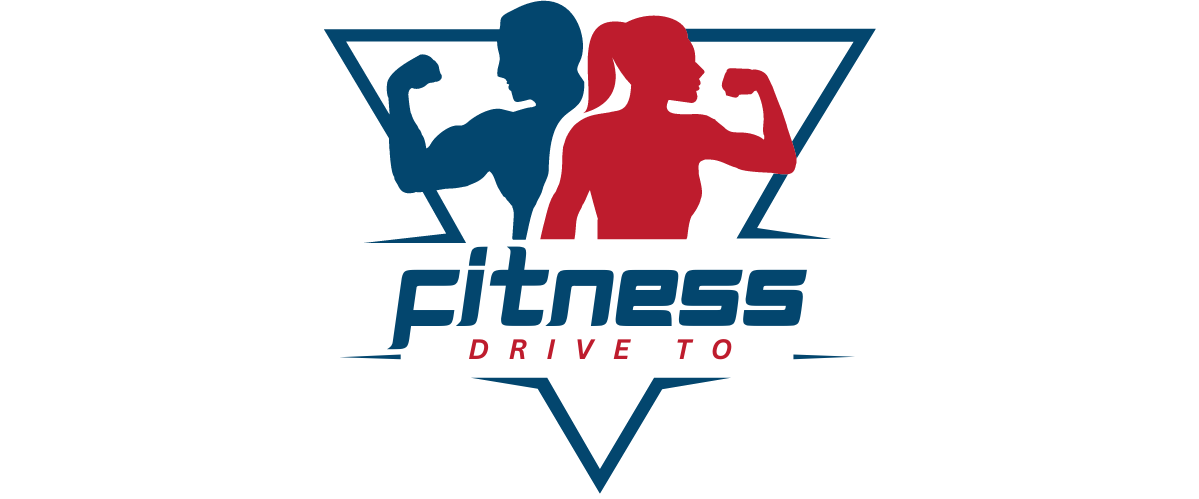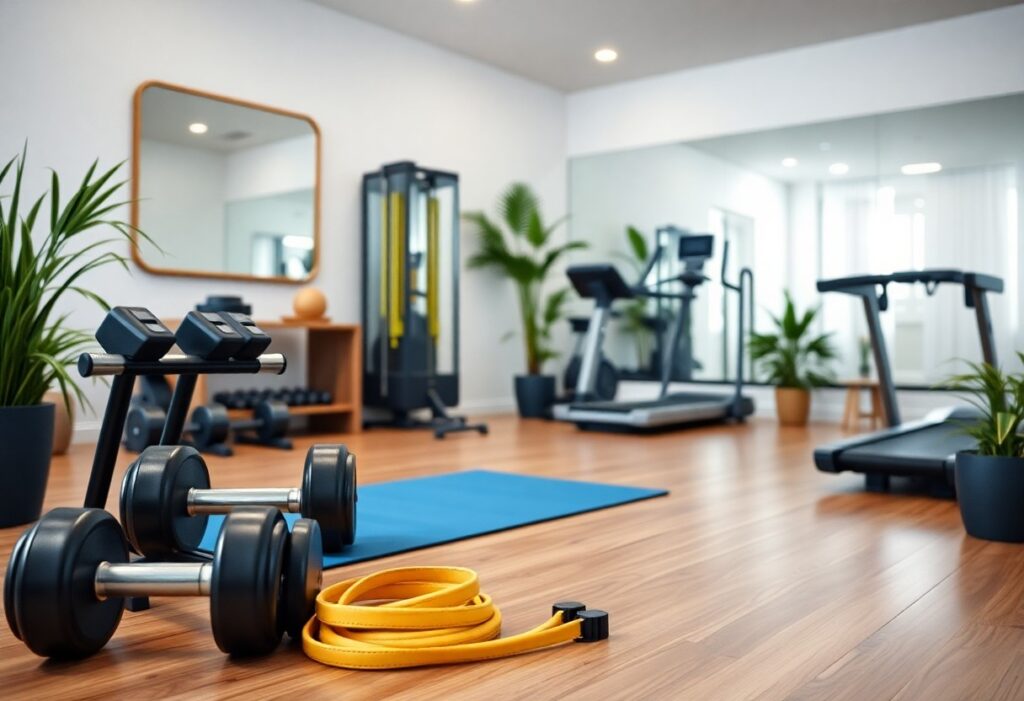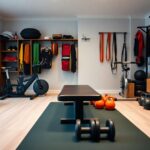As you launch on creating your ideal home gym, your safety and goals are top priorities. You want a space that caters to your fitness level, whether you’re a beginner or an athlete. With proper equipment and planning, you can achieve a functional and motivational environment that helps you stay consistent and reach your targets. This guide will walk you through the crucials to consider, ensuring you create a home gym that meets your needs and supports your wellness journey.
Key Takeaways:
To create an effective home gym, consider the following points:
- Define your fitness goals to determine the type of equipment and space you need, ensuring your home gym is tailored to your specific workout routine.
- Assess your available space and choose equipment that fits comfortably, allowing for a safe and efficient workout environment.
- Invest in necessary equipment such as dumbbells, a treadmill, or a stationary bike to provide a solid foundation for your home gym.
- Consider ergonomics and safety features when selecting equipment, ensuring a comfortable and injury-free workout experience.
- Don’t forget to incorporate storage solutions and ventilation systems to keep your home gym organized, clean, and well-maintained, promoting a healthy workout environment.

Types of Home Gyms
While planning your home gym, consider the space and equipment you need. You can choose from:
- Basic
- Intermediate
- Advanced
Any home gym type requires a solid plan.
| Home Gym Type | Description |
|---|---|
| Basic | Essential equipment |
| Intermediate | Additional equipment |
| Advanced | Specialized equipment |
| Custom | Tailored to your needs |
| Portable | Equipment for travel |
Small Space Home Gyms
Assuming you have limited space, you can still create a functional home gym with multi-purpose equipment and a well-planned layout.
Full-Service Home Gyms
Some people prefer a comprehensive setup with various equipment and advanced features.
Types of equipment in full-service home gyms include treadmills, ellipticals, and free weights, which can be dangerous if not used properly. You should always warm up before using any equipment and cool down afterwards to avoid
Essential Equipment for Every Fitness Level
One of the most significant investments you’ll make in your home gym is the equipment. You’ll want to choose pieces that align with your fitness goals and level.
Beginner-Friendly Equipment
Limited to no equipment is needed for a great workout, but some basics can enhance your experience. You can start with resistance bands, dumbbells, or a yoga mat.
Advanced Training Equipment
Little by little, you can upgrade your home gym with more advanced equipment. Consider the following:
- Treadmill
- Stationary bike
| Equipment | Benefits |
|---|---|
| Treadmill | Cardiovascular workout |
| Stationary bike | Low-impact exercise |
Little do you know, advanced equipment can take your workouts to the next level.
Equipment such as treadmills and stationary bikes provide an intense cardiovascular workout. Consider the following:
- Safety features such as emergency stops
- Durable construction for long-term use
| Feature | Importance |
|---|---|
| Adjustable resistance | Customizable workout |
| Heart rate monitoring | Tracking progress |
Step-by-Step Guide to Creating Your Dream Home Gym
Keep in mind that creating your dream home gym requires careful planning. The process can be broken down into:
| Step | Description |
|---|---|
| 1 | Planning and designing your space |
| 2 | Setting up and organizing equipment |
Planning and Designing Your Space
Clearly, defining your fitness goals and available space is crucial. You will need to consider the size and layout of your room, as well as the type of equipment you want to include.
Setting Up and Organizing Equipment
Designing a functional layout is key to a successful home gym. You should consider the safety and efficiency of your equipment setup, ensuring that you have enough space to move around comfortably.
The most important aspect of setting up and organizing your equipment is to prioritize safety. You should ensure that your equipment is properly assembled and secured to avoid any accidents or

Factors to Consider When Building Your Home Gym
Once again, you’ll need to consider several factors, including
- space
- budget
- equipment
, to create your ideal home gym. Thou should prioritize your fitness goals and choose equipment that suits your needs.
Budget and Cost Considerations
Equally, you must assess your financial situation and set a realistic budget for your home gym, considering the cost of equipment and installation.
Space and Layout Considerations
Whenever you plan your home gym, consider the available space and create a functional layout that allows for safe and effective workouts.
Space is a limited resource in many homes, so you’ll need to optimize your gym’s layout to accommodate your fitness equipment and personal space. You should also consider safety features, such as mirrors and ventilation, to create a comfortable and effective workout environment, which will help you achieve your fitness goals.
Tips for Optimizing Your Home Gym Experience
After setting up your home gym, consider space optimization and equipment maintenance for a better experience. You can:
- Use mirrors for feedback
Check out Creating Your Dream Home Gym: A Comprehensive Guide for more tips. Assume that your home gym will be a success with these tips.
Creating a Motivational Environment
For a productive workout, create a conducive atmosphere with music and inspirational quotes. You will be more motivated to exercise in a welcoming space.
Staying Safe and Avoiding Injuries
Even with the best equipment, safety is a top priority. You should always warm up and cool down to prevent injuries.
Optimizing your home gym experience involves proper equipment use and regular maintenance to avoid accidents and injuries. You can prevent overexertion and strain by listening to your body and taking regular breaks. This will help you have a safe and effective workout, allowing you to achieve your fitness goals.

Pros and Cons of Having a Home Gym
All things considered, having a home gym has its advantages and disadvantages.
| Pros | Cons |
|---|---|
| Convenience | High upfront costs |
| Privacy | Maintenance requirements |
| Time-saving | Distractions at home |
| Customization | Space constraints |
Benefits of Convenience and Privacy
The ability to work out from the comfort of your own home provides convenience and privacy, allowing you to focus on your fitness goals without distractions.
Drawbacks of Maintenance and Distractions
Maintenance of your home gym is necessary to ensure your equipment remains in good condition, but it can be time-consuming and take away from your actual workout time, and you may face distractions at home that hinder your progress.
Distractions, such as family members or household chores, can be a significant Barrier to your success, so it’s important to find ways to minimize them and stay focused on your fitness goals, and you can do this by setting aside a dicated space for your home gym and establishing a routine that works for you.
Conclusion
So, you now have the knowledge to create your dream home gym, tailored to your fitness level and goals. You can design a space that motivates you to reach new heights, with the right equipment and layout. By following this guide, you will be able to make informed decisions and create a gym that suits your unique needs, helping you achieve your fitness objectives and enjoy the process.
FAQ
Q: What are the benefits of having a home gym, and how can it help me achieve my fitness goals?
A: Having a home gym offers numerous benefits, including convenience, cost-effectiveness, and personalized workout experience. With a home gym, you can work out at any time, eliminating the need to commute to a commercial gym. This flexibility can help you establish a consistent workout routine, leading to improved overall fitness and increased motivation to achieve your goals. Additionally, a home gym allows you to tailor your workouts to your specific needs and preferences, ensuring that you target the right muscle groups and exercises to achieve optimal results.
Q: What are the important equipment and components that I need to create a well-rounded home gym for every fitness level?
A: To create a comprehensive home gym, you’ll need a combination of cardio equipment, strength training gear, and functional training tools. Some must-haves include a treadmill or stationary bike for cardio, a set of dumbbells or a weight bench for strength training, and a pull-up bar or resistance bands for functional exercises. You may also consider investing in a mirror, flooring, and storage solutions to create a safe and efficient workout space. The specific equipment you choose will depend on your fitness goals, available space, and budget.
Q: How do I determine the ideal space and layout for my home gym, and what factors should I consider when designing the layout?
A: When determining the ideal space for your home gym, consider the size of the room, ceiling height, and any obstacles or limitations. A minimum of 10×10 feet of open space is recommended, but you can work with smaller areas by using wall-mounted equipment and foldable gear. Think about the flow of your workout routine and position equipment to allow for a logical and efficient transition between exercises. Additionally, consider factors like lighting, ventilation, and electrical outlets to ensure a safe and comfortable workout environment.
Q: What safety precautions and measures should I take when setting up and using my home gym, especially if I’m new to working out or have any health concerns?
A: When setting up and using your home gym, it’s important to prioritize safety to avoid injuries and ensure a healthy workout experience. Start by consulting with a medical professional or certified personal trainer, especially if you have any health concerns or are new to working out. Make sure to read and follow the manufacturer’s instructions for each piece of equipment, and take the time to learn proper form and technique for each exercise. You should also invest in a good quality mat or flooring to provide cushioning and traction, and keep a first aid kit and phone nearby in case of emergencies.
Q: How can I stay motivated and track my progress when working out at home, and what tools or resources can help me achieve my fitness goals?
A: Staying motivated and tracking progress is key to achieving your fitness goals. Consider investing in a fitness tracker or smartwatch to monitor your workouts and set goals for yourself. You can also use mobile apps, online workout platforms, or social media to connect with like-minded individuals, find new workout ideas, and share your progress with friends and family. Additionally, create a workout schedule and stick to it, rewarding yourself for milestones achieved and celebrating small victories along the way. Having a workout buddy or accountability partner can also help keep you motivated and engaged in your fitness journey.


